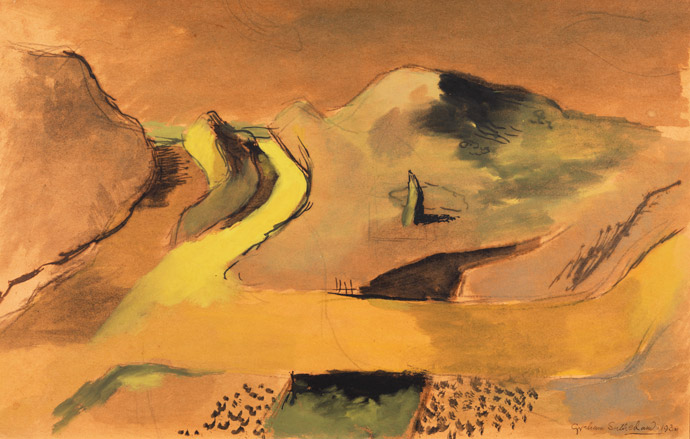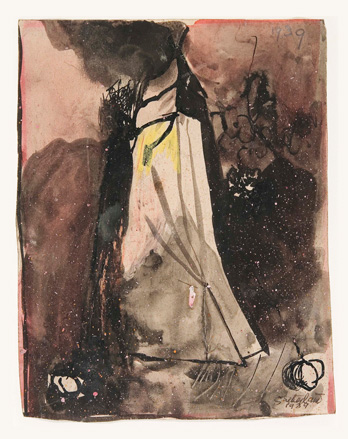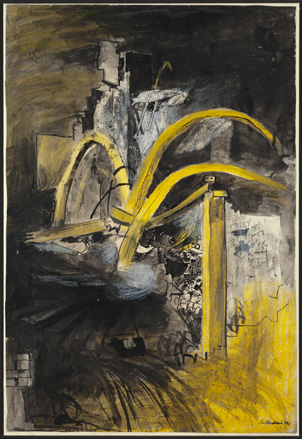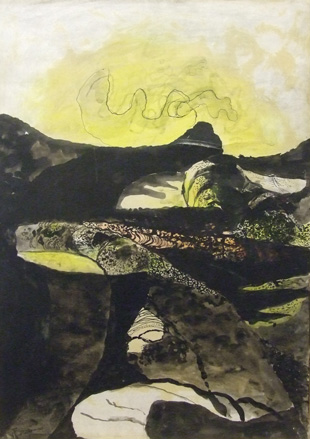Graham Sutherland show at Modern Art Oxford, UK

He painted powerful scenes of bombed-out Swansea, Cardiff and East London, and gritty landscapes of quarries, mines and foundries as his role as official WWII artist, but today the late Graham Sutherland is still in the shadows of his friend and contemporary Francis Bacon. A show at Modern Art Oxford is hoping to change all this. Featuring more than 80 of Sutherland's landscapes of Pembrokeshire from the 1930s and the 1970s, the show is curated by 2011 Turner Prize nominee George Shaw.
It's a neat fit, as Shaw, who paints his home town of Coventry, is also a master of the bleak British landscape. Beyond that though, the idea came about 'after a really drunken night with the gallery director Michael Stanley two years ago,' says Shaw, who first came across Sutherland's 1950s tapestry 'Christ in Glory in the Tetramorph', in Coventry Cathedral as a boy. For him, Sutherland's Wales - an ancient place of setting suns, sacred stones, prehistoric figures and foreboding rock formations, and presented in the show in various phases of abstraction - 'sums up the artist's vision'.
Sutherland graduated from Goldsmiths School of Art with a degree in engraving and etching in 1925, and moved to Pembrokeshire in 1930 before becoming a war artist and travelling the UK to document its troubles. Surreal touches - Cezanne-like mountains, Monet-esque haystacks and Picasso-style symbols - appear in his work, and in 1949 Sutherland moved to the South of France where he spent 20 years painting Mediterranean landscapes.
'For me, Pembrokeshire is him; this is his work,' says Shaw, strolling enthusiastically through the gallery's four rooms, in which sketches and works-in-progress are also on show. 'I'm not that interested in finished things, in artists' grand gestures. Sutherland's studies are so full of life. He would get out of his Bentley, do a very quick sketch and take it - all in his mind - back to the studio.'
In contrast to his life of isolation in Wales, Sutherland was also a society man; in 1949, he painted Somerset Maugham, Lord Beaverbrook and Winston Churchill. So outré was the latter's portrait that it was burned by the family. 'In this respect, he was the Damien Hirst of his day,' says Shaw. 'His work was cutting edge and shocking to the point where it was destroyed. Yet people have never heard of him.'
Sutherland died in 1980 and many of the works in the show haven't seen the light of day since the 1960s. Adds Shaw: 'He's just not on the radar, yet he is totally contemporary. His paintings of war-torn east London could be Afghanistan today.'

'Mountain Landscape', 1936
National Museum Wales

'Sun Setting Between Hills', 1937
Private Collection

Study for 'Blasted Oak', 1937
National Museum Wales

'Gypsy Tent', 1939
National Museum Wales

'Tree Forms in Estuary', 1939
Doncaster Metropolitan Borough Council

'Trees Under Mynedd Pen Cyrm', 1939
Trustees of the Cecil Higgins Art Gallery, Bedford

'The Wanderer', 1940

'Dark Hill - Landscape with Hedges and Fields', 1940

'Devastation or The City: Twisted Girders', 1941

'Landscape Study of Cairns', 1944
(Kearley Bequest through the Art Fund, 1989)

'Twisted Tree Form', 1944

'The Setting Sun', 1944

'Thorns', 1945

'Thorn Head', 1945
(Bequeathed by Paul Clark, 2010)

'Two Trees', 1947

'Road Mounting between Hedges: Sunrise', 1949
Presented by the Contemporary Art Society in 1955, Kirklees Collection

'Landscape', 1969
ADDRESS
Wallpaper* Newsletter
Receive our daily digest of inspiration, escapism and design stories from around the world direct to your inbox.
30 Pembroke Street
Oxford OX1 1BP
UK
Emma O'Kelly is a freelance journalist and author based in London. Her books include Sauna: The Power of Deep Heat and she is currently working on a UK guide to wild saunas, due to be published in 2025.
-
 All-In is the Paris-based label making full-force fashion for main character dressing
All-In is the Paris-based label making full-force fashion for main character dressingPart of our monthly Uprising series, Wallpaper* meets Benjamin Barron and Bror August Vestbø of All-In, the LVMH Prize-nominated label which bases its collections on a riotous cast of characters – real and imagined
By Orla Brennan
-
 Maserati joins forces with Giorgetti for a turbo-charged relationship
Maserati joins forces with Giorgetti for a turbo-charged relationshipAnnouncing their marriage during Milan Design Week, the brands unveiled a collection, a car and a long term commitment
By Hugo Macdonald
-
 Through an innovative new training program, Poltrona Frau aims to safeguard Italian craft
Through an innovative new training program, Poltrona Frau aims to safeguard Italian craftThe heritage furniture manufacturer is training a new generation of leather artisans
By Cristina Kiran Piotti
-
 The art of the textile label: how British mill-made cloth sold itself to Indian buyers
The art of the textile label: how British mill-made cloth sold itself to Indian buyersAn exhibition of Indo-British textile labels at the Museum of Art & Photography (MAP) in Bengaluru is a journey through colonial desire and the design of mass persuasion
By Aastha D
-
 From counter-culture to Northern Soul, these photos chart an intimate history of working-class Britain
From counter-culture to Northern Soul, these photos chart an intimate history of working-class Britain‘After the End of History: British Working Class Photography 1989 – 2024’ is at Edinburgh gallery Stills
By Tianna Williams
-
 Surrealism as feminist resistance: artists against fascism in Leeds
Surrealism as feminist resistance: artists against fascism in Leeds‘The Traumatic Surreal’ at the Henry Moore Institute, unpacks the generational trauma left by Nazism for postwar women
By Katie Tobin
-
 From activism and capitalism to club culture and subculture, a new exhibition offers a snapshot of 1980s Britain
From activism and capitalism to club culture and subculture, a new exhibition offers a snapshot of 1980s BritainThe turbulence of a colourful decade, as seen through the lens of a diverse community of photographers, collectives and publications, is on show at Tate Britain until May 2025
By Anne Soward
-
 Jasleen Kaur wins the Turner Prize 2024
Jasleen Kaur wins the Turner Prize 2024Jasleen Kaur has won the Turner Prize 2024, recognised for her work which reflects upon everyday objects
By Hannah Silver
-
 Peggy Guggenheim: ‘My motto was “Buy a picture a day” and I lived up to it’
Peggy Guggenheim: ‘My motto was “Buy a picture a day” and I lived up to it’Five years spent at her Sussex country retreat inspired Peggy Guggenheim to reframe her future, kickstarting one of the most thrilling modern-art collections in history
By Caragh McKay
-
 Please do touch the art: enter R.I.P. Germain’s underground world in Liverpool
Please do touch the art: enter R.I.P. Germain’s underground world in LiverpoolR.I.P. Germain’s ‘After GOD, Dudus Comes Next!’ is an immersive installation at FACT Liverpool
By Will Jennings
-
 ‘Regeneration and repair is a really important part of how I work’: Bharti Kher at Yorkshire Sculpture Park
‘Regeneration and repair is a really important part of how I work’: Bharti Kher at Yorkshire Sculpture ParkBharti Kher unveils the largest UK museum exhibition of her career at Yorkshire Sculpture Park
By Will Jennings